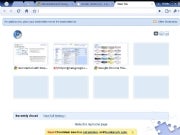Perfect integration of hardware and software.
Since the software on every Mac is created by the same company that makes the Mac itself, you get an integrated system in which everything works together perfectly. The advanced technologies in the operating system take full advantage of the 64-bit, multicore processors and GPUs to deliver the greatest possible performance. The built-in iSight camera works seamlessly with the iChat software so you can start a video chat with a click. Your Mac notebook includes a Multi-Touch trackpad that supports pinching, swiping, and other gestures. And the OS communicates with the hardware to deliver incredible battery life by spinning down the hard drive when it’s inactive, by intelligently deciding whether the CPU or GPU is best for a task, and by automatically dimming the screen in low-light conditions.Elegant interface and stunning graphics.
The most striking feature of a Mac is its elegant user interface, made possible by graphics technologies that are built to leverage the advanced graphics processor in your Mac. These technologies provide the power for things like multiway chatting, real-time reflections, and smooth animations. Fonts on the screen look beautiful and extremely readable. A soft drop shadow makes it clear at a glance which window is active and which ones are in the background. You can preview just about any type of file using Quick Look, and because the previews are high resolution, you can actually read the text. Built-in support for the PDF format means you can view or create PDFs from almost any application in the system.- Testing conducted by Apple in August 2009 comparing prerelease Mac OS X v10.6 Snow Leopard with shipping Mac OS X v10.5.8 Leopard. Testing was conducted on a shipping 2.0GHz MacBook system and a shipping 2.66GHz iMac system, both configured with 2GB of RAM. Performance will vary based on system configuration, network, file sizes, data sets, and other factors. These tests reflect the approximate performance of Mac OS X.
- Testing conducted by Apple in August 2009 comparing prerelease Mac OS X v10.6 Snow Leopard with shipping Mac OS X v10.5.8 Leopard. Testing was conducted on a production 2.16GHz MacBook system and a production 2.4GHz iMac system, both configured with 1GB of RAM. Performance will vary based on system configuration, data sets, and other factors. These tests reflect the approximate performance of Mac OS X.
- Based on 4 minutes per song and 128-Kbps AAC encoding; actual capacity varies by encoding method and bit rate.
- Video chatting requires a broadband Internet connection; fees may apply.
- Location information depends on data collected by third parties. These data services are subject to change and may not be available in all geographic areas, resulting in location information that may be unavailable, inaccurate, or incomplete.
- Testing conducted by Apple in August 2009 comparing prerelease Mac OS X v10.6 Snow Leopard with shipping Mac OS X v10.5.8 Leopard. Testing was conducted on a shipping 2.0GHz MacBook system and a shipping 2.66GHz iMac system, both configured with 2GB of RAM. JavaScript benchmarks based on the SunSpider Performance test. Performance will vary based on system configuration, network connection, and other factors. These tests reflect the approximate performance of Mac OS X.
Mac OS X is the world’s most advanced operating system. Built on a rock-solid UNIX foundation and designed to be simple and intuitive, it’s what makes the Mac innovative, highly secure, compatible, and easy to use. Quite simply, there is nothing else like it.

Anatomy of a Mac
A quick overview of the basics, so you can see how easy it is to get started with a new Mac. Watch now

Power of UNIX. Simplicity of the Mac.
Mac OS X is both easy to use and incredibly powerful. Everything — from the desktop you see when you start up your Mac to the applications you use every day — is designed with simplicity and elegance in mind. So whether you’re browsing the web, checking your email, or video chatting with a friend on another continent,* getting things done is at once easy to learn, simple to perform, and fun to do. Of course, making amazing things simple takes seriously advanced technologies, and Mac OS X is loaded with them. Not only is it built on a rock-solid, time-tested UNIX foundation that provides unparalleled stability, it also delivers incredible performance, stunning graphics, and industry-leading support for Internet standards.
Highly secure by design.
Mac OS X doesn’t get PC viruses. And with virtually no effort on your part, Mac OS X protects itself from other malicious applications. It was built for the Internet in the Internet age, offering a variety of sophisticated technologies that help keep you safe from online threats. Because every Mac ships with a secure configuration, you don’t have to worry about understanding complex settings. Even better, it won’t slow you down with constant security alerts and sweeps. And Apple responds quickly to online threats and automatically delivers security updates directly to your Mac. Learn more
Built for compatibility.
The versatility and power of Mac OS X make it compatible in almost any environment, including Windows networks. It works with virtually all of today’s digital cameras, printers, and other peripherals without the need to manually download separate drivers. It opens popular file types such as JPG, MP3, and Microsoft Word, Excel, and PowerPoint documents. In addition, Mac OS X includes built-in support for the industry-standard PDF format, so you can read and create PDFs from almost any application in the system — perfect for sharing work with colleagues whether they use a Mac or a PC. If you want to run Windows on your Mac, you can do that, too. And Mac OS X Snow Leopard is the only operating system with built-in support for the latest version of Microsoft Exchange Server, so you can use your Mac at home and at work and have all your messages, meetings, and contacts in one place. Learn more
Innovation for everyone.
Mac OS X comes standard with a wide range of assistive technologies that help people with disabilities experience what the Mac has to offer — including many features you won’t find in other operating systems at any price. For example, the built-in VoiceOver screen-reading technology makes it possible for those who are blind or have low vision to control their computer using key commands or gestures on a Multi-Touch trackpad. Mac OS X also offers out-of-the-box support for over 40 braille displays, including Bluetooth displays, and many other accessibility features, such as dynamic full-screen magnification, playback of closed captions, and a scalable screen. Learn more
Reliable to the core.
The core of Mac OS X is built on the same ultrareliable UNIX foundation that powers industrial-strength servers, helping to ensure that your computing experience remains free from system crashes and compromised performance. Even upgrading your Mac to the next version of Mac OS X is reliable and easy. It checks your applications to make sure they’re compatible and sets aside any programs known to be incompatible. If a power outage interrupts your installation, it can start again without losing any data. Best of all, upgrading doesn’t require reformatting your drive; you can keep all your compatible applications, files, and settings. And if something goes wrong when you’re using your Mac, Time Machine is there to keep automatic backups of everything on your drive.
Fully featured, fully loaded.
Mac OS X comes in a single, full-featured version that includes a large collection of beautifully designed applications. They not only let you surf the web, conduct video and text chats, manage your contacts, and accomplish other day-to-day tasks — they also work together to make you more productive and let you have more fun.- * Video chatting requires a broadband Internet connection; fees may apply.













